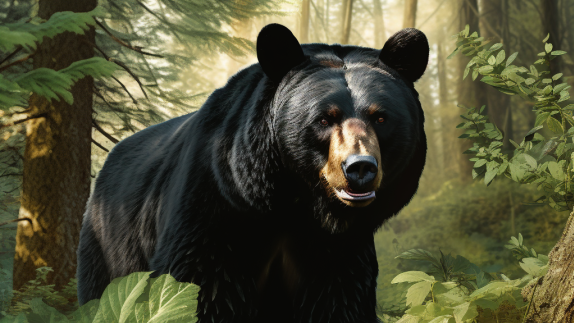
Black Bears: Great Smoky Mountains NP Safety Tips
Great Smoky Mountains National Parks Safety Tips:
What Do I Do If I See A Bear?
Bears in the park are wild and their behavior can be unpredictable. Although extremely rare, attacks on humans have occurred, inflicting serious injuries and death. Treat bear encounters with extreme caution! Learn what to do if you see a bear by watching this short video.
If you see a bear:
Remain watchful.
Do not approach it
Do not allow the bear to approach you.
If the bear is at a distance, feeding or walking by, and notices you but continues its natural behavior, no action is needed on your part. Proceed while continuing to observe the bear.
If your presence causes the bear to change its behavior (stops feeding, changes its travel direction, watches you, etc.) you are too close.
Being too close may promote aggressive behavior from the bear such as running toward you, making loud noises, or swatting the ground. The bear is demanding more space. Don't run, but slowly back away, watching the bear. Increase the distance between you and the bear. The bear will probably do the same.
If a bear persistently follows or approaches you, without vocalizing, or paw swatting:
Change your direction.
If the bear continues to follow you, stand your ground.
If the bear gets closer, talk loudly or shout at it.
Act aggressively to intimidate the bear.
Act together as a group if you have companions. Make yourselves look as large as possible (for example, move to higher ground).
Throw non-food objects such as rocks at the bear.
Use a deterrent such as a stout stick.
If you are carrying bear spray, begin to discharge it when the bear comes within 20 yards of you. Watch this video on how to safely use bear spray.
Don't run and don't turn away from the bear.
Don't leave food for the bear; this encourages further problems.
Don't discharge a firearm; this can cause a safety hazard for other visitors.
If the bear's behavior indicates that it is after your food and you are physically attacked:
Separate yourself from the food.
Slowly back away.
If the bear shows no interest in your food and you are physically attacked, the bear may consider you as prey:
Fight back aggressively with any available object!
Do not play dead!
Help protect others, and report all bear incidents to a park ranger immediately. Above all, keep your distance from bears!
Stay safe in black bear country! Please watch this short video.
Black bears are dangerous and unpredictable wild animals. Do not approach bears or allow them to approach you.
Bears in the Smokies
Great Smoky Mountains National Park is one of the largest protected areas in the eastern United States where black bears can live in wild, natural surroundings.
Bears inhabit all elevations of the park. Though populations are variable, biologists estimate that roughly 1,900 bears live in the park. This equals a population density of approximately two bears per square mile. At one time, the black bear's range included most of North America except the extreme west coast. However, loss of habitat has resulted in a significant reduction in this range.
Black bears in the Smokies are black in color, but in other parts of the country, they may be brown or cinnamon. They may be six feet in length and up to three feet high at the shoulder. During the summer months, a typical adult male bear weighs approximately 250 pounds while adult females are generally smaller and weigh slightly over 100 pounds. However, bears may double their weight by the fall. Bears over 600 pounds have been documented in the park. Bears can live 12-15 years or more, however, bears that have had access to human foods and garbage have a life expectancy of only half that time.
Bears, like humans, are omnivores. Plant materials such as berries and nuts make up approximately 85% of their diet. Insects and animal carrions provide valuable sources of protein for bears.
Bears have color vision and a keen sense of smell. In addition, they are good tree climbers, can swim very well, and can run 30 miles per hour.
Bear Behavior
Bears are most active during early morning and late evening hours in spring and summer. Mating usually takes place in July. Both female and male bears may have more than one mate during the summer.
Bears choose a denning site with the coming of cold weather. Dens are usually hollow stumps, tree cavities, or wherever there is shelter. Bears in the Smokies are unusual in that they often den high above the ground in standing hollow trees. Bears do not truly hibernate but enter long periods of sleep. They may leave the den for short periods if disturbed or during brief warming trends.
One to four cubs are born during the mother's winter sleep, usually in late January or early February. Bears weigh eight ounces at birth. Females with newly born cubs usually emerge from their winter dens in late March or early April. Commonly born in pairs, the cubs will remain with the mother for about eighteen months or until she mates again.
Trash in fire rings is harmful to wildlife and unsightly. Take the extra step and bring your trash to one of our many fantastic bear-proof dumpsters or trashcans.NPS Photo
Garbage and food scraps Kill Bears!
The bear's keen sense of smell leads it to insects, nuts, and berries, but the animal is also enticed by the tantalizing smells of human food and garbage such as hot dogs, apple cores, chips, and watermelon rinds left on the ground in picnic areas, campgrounds, and along trails. Feeding bears or allowing them access to human food and garbage causes a number of problems:
It changes the bear's behavior and causes them to lose their instinctive fear of humans. Over time, these bears may begin approaching people in search of food and may become more unpredictable and dangerous.
Bears that obtain human food and garbage damage property and injure people. These bears pose a risk to public safety. They can also teach other bears this dangerous behavior. Often, they must be euthanized.
Studies have shown that bears that lose their fear of people by obtaining human food and garbage never live as long as bears that feed on natural foods and are shy and afraid of people. Many are hit by cars and become easy targets for poachers.
For these reasons, park rangers issue citations for littering, feeding bears, and for improper food storage. These citations can result in fines of up to $5,000 and jail sentences lasting up to six months. Visitors are urged to view all wildlife at a safe distance and to never throw food or garbage on the ground or leave it unattended. Garbage Kills Bears!
Help keep the park's bears wild. Do not feed bears. Remember, a fed bear is a dead bear!
Bear Management
Bear management is really people management. How visitors behave while in the park has an impact on the safety of bears. If you are careless with your food or litter, YOU may be responsible for a bear's death!
The park has done many things to make it easier for you to protect bears. Bear proof dumpsters or trash cans can be found in all campgrounds and picnic areas. Please use them to dispose of garbage.
During summer months, some of the busiest picnic areas close at 8:00 PM so these areas can be thoroughly cleaned before dark and any food scraps or trash left by careless visitors can be removed. Park rangers patrol picnic areas and campgrounds to enforce evening closures, littering, and food storage regulations. They also strictly enforce regulations that prohibit approaching, harassing, disturbing, or feeding bears.
An army of park volunteers patrol the park's most popular trails, picnic areas, and campgrounds to educate visitors about protecting bears. They confiscate unattended food or coolers and clean up food scraps left behind by careless visitors. These volunteers also assist in managing people during roadside bear jams.
In the backcountry, food storage cables have been installed to make it easier for backpackers to hang their food and garbage so that bears cannot get to it. At some campsites, telephone poles were flown into remote backcountry areas because the trees around the campsites were too small to set up an effective cable system!
The park's Resource Education staff provides information about bears at visitor centers, in the park's newspaper, and at evening programs. Educational signs about bears can be found on picnic tables throughout the park and bear safety videos are posted on this website.
Wildlife managers actively monitor for bear activity and use innovative and proactive techniques to keep bears shy, secretive, and afraid of people. This approach allows bears to remain in their home range and discourages them from visiting developed areas or approaching people.
The results of these efforts are very encouraging. In some areas, the number of bears that have to be trapped and moved away has decreased by tenfold!
What Can You Do To Protect Bears?
Dispose of all garbage or food scraps in bear-proof garbage containers or take it with you.
Do not feed wildlife. Feeding a bear guarantees its demise!
Do not approach within 50 yards or any distance that disturbs a bear.
Do not allow bears to approach you (See "What Do I Do If I See A Bear?" above).
Use the food storage cables to store your food and garbage when camping in the backcountry.
If you see another visitor breaking these rules, or encounter a bear in a picnic area or campground, on a trail, or in any other developed area, please call (865) 436-1230 or stop at a Visitor Center to report it.
Other Threats to Bears
Non-Native Species: The European wild hog is one of the most direct threats to the black bear. These pervasive intruders feed on the acorns and other foods that are mainstays of bear diets. Another non-native species, the gypsy moth, is expanding its range toward the park. This insect defoliates oak trees, weakening them and leaving them susceptible to other insects and diseases which may kill the trees. Not only could the bear's food source of acorns be affected, but some of the prime denning spots in old-growth trees may be lost.
Poaching: Unfortunately, the lure of high profits on international markets encourages the poaching of black bears. Several cultures believe that bear gall bladders, paws, and claws have medicinal powers or consider them gourmet delicacies.
Urban Encroachment: Community and private developments near park boundaries are causing a loss in habitat for the bears. Poaching activities can be somewhat curtailed, and bear populations can eventually rebound from the losses. But once the critical habitats are destroyed, major declines in bear populations are inevitable. In addition, bears that venture outside park boundaries into neighboring communities may encounter human food and become unpredictable, dangerous, and a threat to human safety.


 How to resolve AdBlock issue?
How to resolve AdBlock issue? 